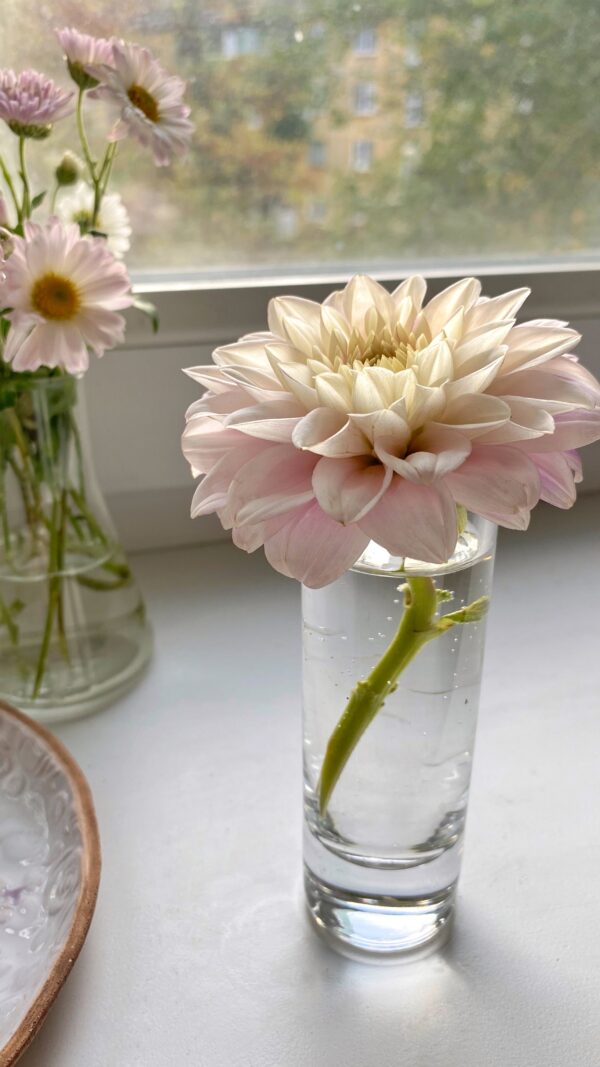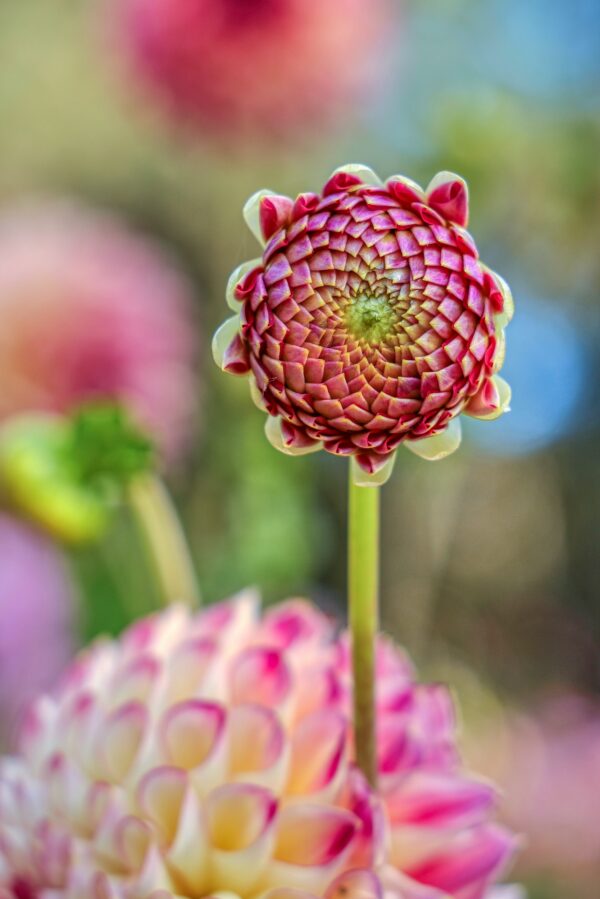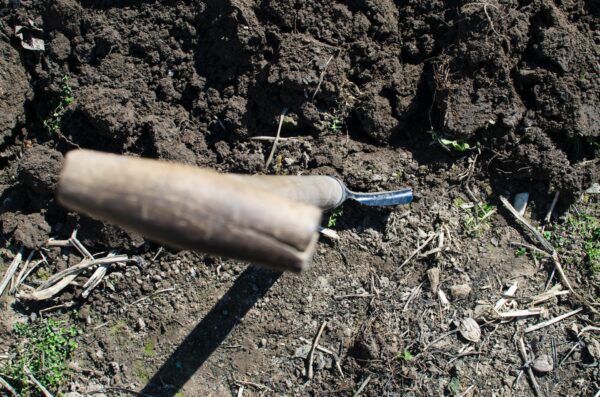
The American Dahlia Association (ADA) currently recognizes 42 species of dahlias. Although dahlias grow better in some regions of the United State than in others, the plants are beloved by fervent gardeners and dabblers alike due to their range of forms and colors and long blooming season. Yet, some aspects of dahlias will keep even the most ardent of green-thumbers from embracing them.
The Dirt Diaries author, Lynn Hunt, who is also an accredited horticultural judge and consulting rosarian emeritus for the American Rose Society, decided to try her hand at dahlias six years ago when she moved from Maryland to Sapphire, N.C. “I discovered the head-turning beauty of dahlias,” said Hunt, “… what a delicious addition to the landscape they are, with colors in every shade but blue and blooms as small as a pincushion or as big as a dinner plate.”
Dahlias fill vases from late spring/early summer until fall and are relatively “easy to grow,” noted Hunt. But when that first fall frost threatens, dahlia growers are faced with a dilemma: “Dig up the tubers and store them? Or take a chance and leave them in the ground?”

Hunt said there are benefits and drawbacks to both methods. One year she dug them up and stored them and they “shriveled,” but she has known people to leave dahlia tubers in the ground, only to have them freeze and die.
Drew English usually opts for digging and storing. Manager since 2018 of the almost century-old dahlia garden at historic High Hampton Resort, Cashiers, N.C., English was first a fan of the flowers before he became their professional caretaker. He recalled: “It was in the summer of 2010 that I first saw the High Hampton dahlia garden, and I was struck by the amazing variety of blooms. I was in love! Having been born and raised in the low country of South Carolina, the dahlia was a plant that was foreign to me, but no longer. I read, studied, and investigated all there was to know about the species.”

English’s first personal dahlia purchase was a deep purple dinner-plate variety called ‘Thomas Edison.’ “From that point on, my garden grew … evolving from my humble little 12-foot by 6-foot-fenced bed to a now terraced hillside garden of about 110 plants. Some of my favorite cultivars are ‘Hollyhill Spider Woman,’ a large purple and white variegated cactus bloom, ‘Show-n-Tell,’ a vibrant red and orange dinner plate dahlia with huge luscious petals, and ‘Maarn,’ with its perfectly delicious orange sherbet spherical ball bloom.”
But then English decided to make dahlias not just an enjoyment but a profession. High Hampton’s dahlia garden has been moved around the resort property several times, but it is currently front and center near the entryway and features at least 300 varieties, including a few originally grown by the resort’s founder, Dr. William Halsted, who purchased varieties from Europe priced at upwards of $1,000.
“The High Hampton garden has 14 ‘old stock’ tubers, also considered ‘legacy tubers,’ which gardeners have been passing down from year to year,” he said, adding, “History and tradition have always been very important to me, and in some way, I feel a responsibility to continue the passion of the Halsteads and High Hampton by continuing to grow these marvelous plants.”
During the spring-to-fall growing season, dahlias are generous with their blooms. However, like all plants, they do have specific needs. According to the ADA, the plants will grow in pots or beds, but they need an environment with adequate drainage and partial-to-full sun.
Dahlias need to be planted in “healthy” soil “full of organic matter,” advised English. “I plant 700 to 800 dahlias [at High Hampton] and add organic compost annually and regularly test soil. A lot of pests and diseases can be eliminated just by having good soil.”

He added: “Dahlias love sun – 6-8 hours a day. If they don’t get enough sun, they become stringy and leggy. But really hot sun in some Southern areas dries them out fast and they wilt. That is why people don’t usually try to grow dahlias in the mid-to-lower regions of South Carolina, in Florida, etc. The mountainous areas and Pacific Northwest don’t have oppressive heat, and those regions have cooler summer nights, which allows dahlias to recuperate.”
Regarding watering, ADA warns that excessive watering of young plants can lead to rot. A rule of thumb for maturing and mature plants is to water them if the local rainfall is less than one inch in seven days. Pots, however, dry out more quickly and may require regular watering.
English manages High Hampton’s dahlias for their beauty as well as to provide resort members with a cutting garden. He advises members to “cut severely” – meaning not just the one flower but the tri-stem – so stems become stronger and can hold more future blooms.
Back to Winter-time Prep
English admitted he is still learning the best ways to preserve dahlias through winter months. “Unfortunately, there is no hard and fast rule,” he said. “It’s trial and error because every region’s climate and weather conditions are different.”
Because dahlias grow from tubers, winter dormancy poses challenges. Deciding whether to dig them up and replant in the spring or just leave them in the ground depends on personal choice.
You’re always taking a chance if you leave them in the ground, because some winters are so harsh that they end up freezing – even if covered with plastic and plenty of mulch, such as straw,” said English. “But taking them out of the ground is tricky as well. I always pull the High Hampton tubers because of the legacy of these dahlias. I can’t risk losing them to a cold winter.”
Sometimes, English will leave all or part of his personal dahlias in the ground. To take that route, he instructs:
- After first freeze, cut them back to the ground.
- Place cardboard or several sheets of newspaper down as a first layer and then put a thick layer of compost and then mulch, such as pine or hardwood, over the tubers to insulate.
“Sometimes people put heavy mulch bags on top where the dahlia tubers are. The main thing is to create an insulation layer.”
The main risk to insulating dahlias for the winter, besides freezing, is rotting due to a particularly wet winter.

Digging up dahlia tubers and storing them in semi-dry, mid-40-degree environment for the winter requires these steps:
- Dig them up after they have “gone dormant,” meaning after the first freeze when the plant stops growing.
- Trim off any large roots.
- Clean each tuber with a hose and bucket of water, and let them dry for a few days in the sun. “They still need to be somewhat moist, but not noticeably wet,” he said, “but they also don’t need to be too dried out or they will shrivel.”
- Leave tubers as clumps or divide.
- Store in a sturdy wooden box, vegetable box, or plastic container with holes cut in the lid for ventilation. Mediums for storing include wood shavings, peat moss, vermiculite, or nothing at all.
“Check on them every month throughout the winter to make sure they are not molding,” said English. “If any are molding, take them out and dispose of them because they will cause others to mold. Also, spread out the tubers in the container so they are not touching.”
Dahlia tubers can be stored in a climate-controlled shed or garage, as long as it does not get below freezing or above 50 degrees F. “You don’t want dahlias stored in a house under a bed, for example, because it will be too warm and they will come out of dormancy and begin growing.”
Each spring, after the ground has warmed and there is little threat of frost, stored dahlia tubers can go back into the ground. English plans the High Hampton garden, drives stakes, which provide stability for the plants, and tags each stake based on the type of tuber planted.
ADA instructs: “Put the tuber in a hole several inches deep with the ‘eye’ on the tuber facing up. The eye is the point on the shoulder, or crown, of the tuber from which the plant grows. If you are planting a number of dahlias in the same location, they should be separated by about 2 feet to give each plant room to grow.”
After dahlias begin growing in late spring or early summer, English prunes them. While he quips that many gardeners gasp when he mentions this fact, lack of pruning may result in weak stems. “Pruning, or pinching back, early on, when the plant is about a foot or two, creates hardy stems and a strong base that can hold those heavy blooms. Cut or use fingers to pinch off the plant right above the larger leaves where tiny leaves are sprouting. It doesn’t take long for the plant to grow again and within a few weeks it will bounce back and new buds will form and gardeners get a lot more bang for their buck.”





Be the first to comment